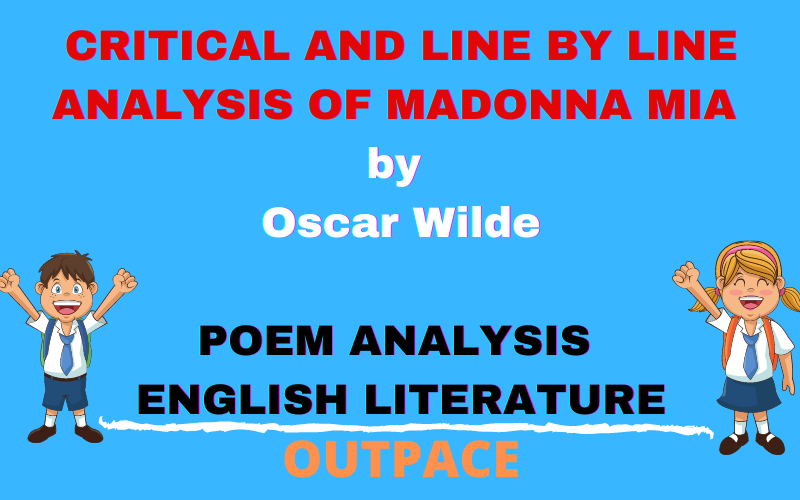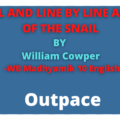About the Poet
Oscar Fingal O’Flahertie Wills Wilde was born on 16th October 1854 in Dublin, Ireland. He was born to Lady Jane Wilde and William Wilde, an Anglo- Irish couple. He was a poet and a playwright. Wilde got baptised in an Anglican church. He is known for his poems and epigrams. Wilde could fluently speak German and French. He studied in Trinity College, Dublin and then in Oxford. Wilde was an excellent student.
After university, he lectured on “English Renaissance in Art” and interior decoration as well. his most famous creation is the novel “The Picture of Dorian Gray” published in 1891 in a book form. Oscar Wilde was deeply influenced by Catholicism.
Wilde had also worked as a journalist and had a theatrical career as well. He got married to Constance Lloyd in 1884.
He was an important part of the Aesthetic movement and the Decadent movement. Some of his most significant creations are “A House of Pomegranates” (1891), “Poems” (1881), “Ravenna” (1878), “The Sphinx” (1894), “A Woman of No Importance” (1893), “Intentions” (1891), “The Ballad of Reading Gaol” (1898), “An Ideal Husband” (1895), “De Profundis” (1897), “The Importance of Being Earnest” (1895), “The Happy Prince and other stories” (1888) and a lot more.
Wilde passed away at the age of 46 in Paris on November 30, 1900.
About the Poem
‘Madonna Mia’ in Italian means ‘Oh god!’ or ‘Oh Mary!’ to be specific. This poem was penned down in order to praise The Virgin Mary. It was first published in the college magazine of Trinity College called Kottabos and the title was “Wasted Days”. In 1881, this sonnet was rewritten and was included in Wilde’s collection of poetry called “Poems”. The gender of the main subject of the poem was also changed. “Wasted Days” had an aesthetic angle to it, whereas, “Madonna Mia’ has a predominant religious touch to it. It is neither a Petrarchan sonnet nor a Shakespearian sonnet. It is atypical sonnet.
Structure of the Poem
Madonna Mia
A lily-girl, not made for this world’s pain, With brown, soft hair close braided by her ears, And longing eyes half veiled by slumberous tears Like bluest water seen through mists of rain: Pale cheeks whereon no love hath left its stain, Red underlip drawn in for fear of love, And white throat, whiter than the silvered dove, Through whose wan marble creeps one purple vein. Yet, though my lips shall praise her without cease, Even to kiss her feet I am not bold, Being o’ershadowed by the wings of awe, Like Dante, when he stood with Beatrice Beneath the flaming Lion’s breast, and saw The seventh Crystal, and the Stair of Gold.
“Madonna Mia” is an Italian sonnet. Being a typical Italian sonnet, it is divided into two sections: an octave and a sestet. Each verse line contains ten syllables. The rhyming scheme goes as follows: abba acca def dfe.
Despite being an Italian sonnet, the poem has a simple language and there is no use of inversion or abuse of other literary devices.
Line by line analysis of the Poem
Lines 1-8:
“A lily-girl, not made for this world’s pain, With brown, soft hair close braided by her ears, And longing eyes half veiled by slumberous tears Like bluest water seen through mists of rain: Pale cheeks whereon no love hath left its stain, Red underlip drawn in for fear of love, And white throat, whiter than the silvered dove, Through whose wan marble creeps one purple vein.”
The octet consists of the description that the poet has given, in order to explain the purity and sanctity of the Virgin Mary. In the first line, the poet has compared her to a lily to explain how delicate and beautiful she is. She is so gentle that she did not deserve the world’s pain. Her hair is soft and brown and is tied into braids. She had faced to much pain that her eyes are heavy after shedding tears. This pain includes the pain that she felt when Jesus was crucified. Her cheeks are pale and unstained. This is a metaphorical reference to virginal purity. She had her lower lip drawn in, because she feared love or any kind of affectionate touch. Her fair skin had been compared to marble. One could easily see her purple veins peeping beneath her marble-like fair skin. ‘Purple’ and ‘fair skin’ are often indications to royalty and upper class. According to the poet, the Virgin Mary was beautiful, pure and royal.
Lines 9-14:
“Yet, though my lips shall praise her without cease, Even to kiss her feet I am not bold, Being o’ershadowed by the wings of awe, Like Dante, when he stood with Beatrice Beneath the flaming Lion’s breast, and saw The seventh Crystal, and the Stair of Gold.”
In this part of the poem, the attention was shifted from the deity (The Virgin Mary) to the worshipper (the poet himself). These six lines constitute a sestet. In the ninth line, the poet says that he can keep praising The Virgin Mary constantly without any pause. The poet is not even bold enough to kiss her feet out of admiration, because he is awed by her beauty and poise. Beatrice was the muse of the Italian poet Dante and his inspiration to write “The Divine Comedy”. The poet was as awestruck by her as Dante was when he saw the stairs to heaven. This part of the poem shows how religiously influenced the poet had been while writing the poem.
- Looking for love in yonkers?
- Twitive.com Evaluation: Check If It Really Works In 2023
- Самые лучшие онлайн игорные заведения с минимально возможным взносом.
- Онлайн казино с опцией букмекерской конторы
Figures of Speech Used in the Poem
1.Consonance
- Consonance is a figure of speech in which similar consonants are used in neighbouring words with different vowel sounds.
- “And white throat, whiter than the silvered dove”
- “And white throat, whiter than the silvered dove”
2.Alliteration
- This is a figure of speech where closely associated words or corresponding words begin with the same alphabet in a sentence.
- “And white throat, whiter than the silvered dove”
3. Simile
- In this figure of speech, a comparison is made with the usage of any comparing words (“like”, “as”, “then”).
- “And longing eyes half veiled by slumberous tears
Like bluest water seen through mists of rain” - “And white throat, whiter than the silvered dove”
- “Like Dante, when he stood with Beatrice”
4. Metaphor
- In this figure of speech, a comparison is made without the usage of any comparing words.
- “A lily-girl, not made for this world’s pain,”
Here a comparison is made between The Virgin Mary and a lily on the basis of their beauty and delicate nature.
- “Through whose wan marble creeps one purple vein.”
Virgin Mary’s white complexion is compared to marble.
5.Transferred epithet
- In this poetic device, human emotion is associated with a non-living object after getting displaced from the person.
- “And longing eyes half veiled by slumberous tears”
The tears are no ‘slumberous’ here, the poet wanted to convey that Virgin mary is ‘slumberous’ or tired from shedding tears.
Important Word Meanings
- Slumberous: Heavy with drowsiness
- Awe: Admiration.
- Wan: Pale.
- Flaming: Fiery.
- Cease: End.
The theme of the Poem
At the beginning of the poem, it might seem that the poet is describing the beauty and aesthetics of a general woman. However, the title of the poem depicts that the woman is not an ordinary woman but The Virgin Mary. Madonna was another name of Mary. The poet wanted to make a point that Mary is afraid to love or be touched by a man. This is because in Christianity, it is believed that Mary was impregnated by the Holy Spirit and not by Joseph. She maintained her purity by never indulging in sexual practices. Her cheeks were never stained, this indicates her virginal purity. The poet admired The Virgin Mary by bringing the reference to ‘The Divine Comedy’ written by Italian poet Dante Alighieri. There is an evident presence of class consciousness in the sonnet. The whiteness of the skin had been equated to a higher class, especially in the Victorian era. Also, the colour ‘purple’ was equated with royalty and sophistication. The poem is predominantly religious in nature and is filled with praises of The Virgin Mary




